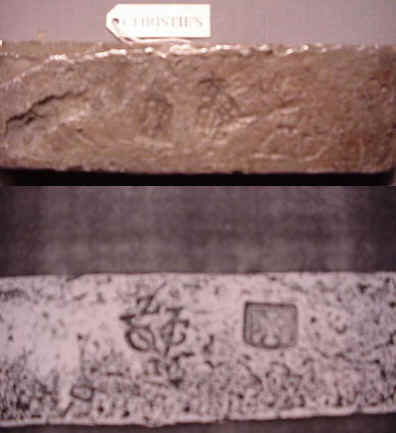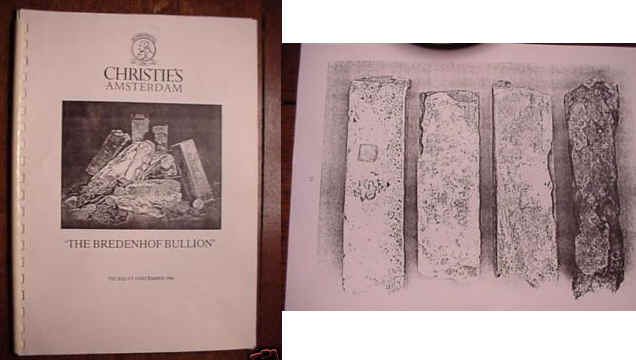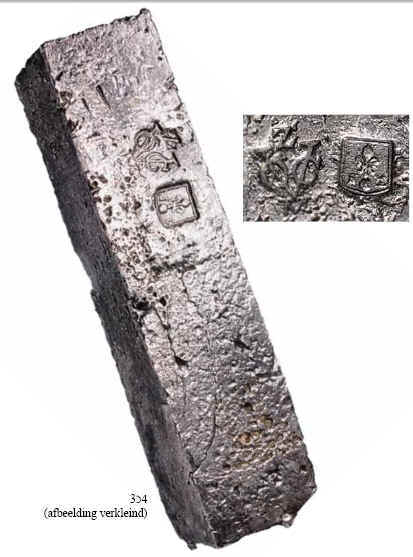

 |
VOC INGOT 1753 SIZE: 16 CM long MEDIUM: SILVER WEIGHT: 1870 gram DECORATION; NONE SALVAGED FROM THE WRECK THE VOC SHIP THE BREDENHOF AGE; 1753 MARKS; VOC( dutch east indian company) MARK, and ZEELAND chambers MARK OF NETHERLANDS CONDITION: USED PROVENANCE: CHRISTIES AMSTERDAM SOLD 1986 US $2.999,00 (EUR 1.883,44), 22-mei-08, ebay, kunstkabinet |
 |
Zilveren baar VOC. Van de Zeeuwse kamer te Middelburg. Ingestempeld met
het VOC. monogram tussen Z en M. Tevens keurmerk van de essayeur. Cartouche met lelie gefl
ankeerd door de initialen E L. Van het VOC schip ‘de Bredenhof’. 1.982 kg.
Ex-Christies veiling. 'The Bredenhof' Bullion 4 december 1986. Schulman, lot 352, 1 dec. 2012, euro 2.000 excl. 20% opgeld |
VOYAGE NR: 3582.3 NAME OF VESSEL: Bredenhof
The Dutch East India Company, commonly called the V.O.C. (Vereenigde Oostindische Compagnie), sent out hundreds of ships in the 17th and 18th Century to trade in the East. This giant conglomerate despatched vast fortunes in silver and gold arount the African continent and through the perilous Indian Ocean to the Company's headquarters in Batavia. The V.O.C. was divided into six Chambers: Amsterdam, Rotterdam, Middelburg, Delft, Hoorn and Enkhuizen.
In September 1752 the Dutch Council of Seventeen of the V.O.C. ordered the Chamber of Middelburg to send the BREDENHOF via Ceylon to Bengal. The BREDENHOF, built in 1746 was a vessel of 136 feet and 800 ton. The voyage to Bengal would be the third and last of the BREDENHOF to the East Indies. In the year 1752 the Chamber of Middelburg not only lost the WAPEN VAN HOORN, but also the famous GELDERMALSEN. In the year 1753 the Chamber would suffer another loss: the BREDENHOF.
The ships KASTEEL VAN TILBURG and ZUIDERBURG of the Chamber Amsterdam were also sent to Bengal. The three ships left Holland at seperate times, carrying with them bar silver, gold ducats and copper 'Duiten' to the value of 1.100.000 guilders. This specie was split among the three ships. The BREDENHOF's cargo manifest was listed as 14 'vaatjes' with copper 'Duiten' and 30 chests with silver and gold. This was made up to 29 chests of bar silver, valued at 300.000 guilders, and one chest with 5.000 gold ducats, valued at 25.000 guilders. The silver was set apart for Bengal to be minted into silver Rupees.
The BREDENHOF sailed from Zeeland on 31 December 1752 and arrived at the Cape on 11 April 1753. Of the 260 men on board of the ship, six were dead and nine were sick. At the Cape the BREDENHOF loaded 38 tons of wheat and some wine for Ceylon. Two weeks later she sailed from the Cape, but did not reach the port of destination.
In calm conditions, but as a result of treacherous counter currents, the BREDENHOF was wrecked on a reef 13 miles from the east coast of Africa and about 120 miles south of Mocambique, the Portuguese settlement on the African coast. This tragedy took place on 6 June 1753. The story became quite fascinating when, out of desperation, the Captain and Ship's Council decided to throw overboard the vast fortune in bar silver, to eliminate plundering by the rest of the crew and by 'other nations'. One can imagine the concern shown by the Dutch Council of Seventeen when the first survivors arrived back in Holland, and told them of this dreadful story. It is evident that the Council was desperate to salvage as much as possible of the bar silver.
Whilst interviewing two survivors from the wreck the Council was told of the utter desperation the crew faced. In the early hours of the morning of 6 June the ship drifted on a dangerous reef. To lighten the ship they jettisoned some cargo, ballast and lastly the cannons overboard. This was still not enough. They then set out the life-boat and barge to drop the two anchors and tried to winch the ship off the reef. The despair was complete when the anchors parted and the boat and barge drifted ashore. They were then left to the mercy of the elements. A gale was blowing from the south-east and the waves were breaking right over the ship.
On 8 June the Quartermaster left with 20 others on the life-boat and sailed to shore. On 11 June the ship started breaking up. At that moment the Captain and Ships Council decided to throw overboard 14 chests of silver through a hole made by a ruddertrunk in the stern. They did not mark the spot with any buoys, as the chests lay in three fathoms of water and could be seen quite easily from the surface. The boat returned to the BREDENHOF to collect some of the crew. Pieter Bakker, the first mate, and two sailors managed to swim through monstrous waves and were picked up by a boat. After another abortive attempt to rescue some of the crew, the life-boat sailed to the Commore Islands in the Mozambique Channel.